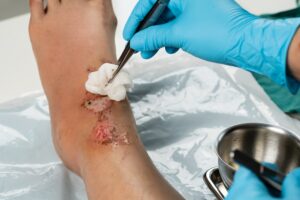Preventing Wound Infections: Essential Strategies for Nurses

Infection prevention stands as a critical pillar in wound care, where even minor oversights can lead to severe complications, prolonged healing, and increased healthcare costs. For nurses on the front lines, mastering strategies to prevent wound infections not only safeguards patient health but also enhances recovery rates and reduces hospital readmissions. This guide outlines essential wound infection prevention techniques tailored for nurses, emphasizing proactive measures in assessment, hygiene, and education. By integrating these practices into daily routines, you’ll contribute to better outcomes in acute, chronic, and post-surgical wound management, aligning with best standards in nursing wound care.
The Role of Nurses in Wound Infection Prevention
Nurses play a pivotal role in identifying infection risks early, as wounds provide an ideal entry point for pathogens. Factors like patient comorbidities (e.g., diabetes or immunosuppression), wound type, and environmental exposures heighten vulnerability. Effective prevention starts with a thorough understanding of infection pathways—bacterial, viral, or fungal—and focuses on breaking the chain through vigilant monitoring and evidence-based interventions. Prioritizing these strategies minimizes antibiotic resistance and supports holistic patient-centered care.
1. Prioritize Hand Hygiene and Personal Protective Equipment
Hand hygiene remains the simplest yet most effective barrier against infection transmission. Wash hands thoroughly with soap and water or use alcohol-based sanitizers before and after every wound interaction, even when wearing gloves. Don appropriate personal protective equipment like gloves, gowns, and masks to create a sterile field, especially during dressing changes. Change gloves if they become contaminated, and dispose of them properly to avoid cross-contamination between patients or sites.
2. Implement Strict Aseptic Techniques
Aseptic techniques form the foundation of safe wound handling. Cleanse wounds with saline or approved antiseptics using a no-touch method to avoid introducing microbes. Prepare all supplies on a clean surface, and use single-use items whenever possible. For invasive procedures like debridement, maintain sterility by organizing tools in advance and minimizing exposure time. Regularly audit your technique to ensure compliance with institutional protocols.
3. Optimize Wound Cleansing and Debridement
Proper cleansing removes debris and reduces bacterial load without damaging healthy tissue. Irrigate gently with normal saline at body temperature, avoiding harsh antiseptics that can impair healing. Debride necrotic or sloughy tissue promptly through autolytic, enzymatic, or mechanical methods to eliminate infection havens. Monitor for biofilm—a slimy layer of microbes—and address it with targeted dressings or agents to prevent chronicity.
4. Choose Appropriate Dressings and Barriers
Select dressings that maintain a moist environment while controlling exudate and providing antimicrobial protection. For high-risk wounds, opt for silver-impregnated or honey-based options to inhibit bacterial growth. Apply occlusive barriers to shield from external contaminants, and change dressings based on exudate levels—frequently for draining wounds but less so for dry ones. Educate on signs of dressing failure, like leakage, to prompt timely interventions.
5. Monitor and Document Wound Progress Vigilantly
Regular assessments catch infections early by tracking changes in pain, odor, exudate, redness, or swelling. Use standardized tools to measure and document findings, noting any deviations from baseline. Involve multidisciplinary teams for complex cases, and report suspected infections immediately for cultures or antibiotics. Consistent documentation supports continuity of care and legal protection.
6. Educate Patients and Caregivers on Self-Care
Empower patients with knowledge to prevent infections at home. Teach proper handwashing, dressing change techniques, and signs of trouble like fever or worsening pain. Provide written instructions and demonstrate methods, tailoring advice to literacy levels and cultural needs. Encourage adherence to follow-up appointments and lifestyle modifications, such as smoking cessation or nutrition optimization, to bolster healing.
7. Promote Systemic Infection Prevention Measures
Beyond local care, address broader risks through vaccination updates, glycemic control in diabetics, and nutritional support to enhance immune function. Implement isolation protocols for contagious cases and ensure environmental cleanliness in care settings. Advocate for institutional policies like antibiotic stewardship to curb resistance, fostering a culture of prevention across the healthcare team.
Conclusion: Building a Culture of Prevention in Wound Care
By adopting these essential strategies, nurses can significantly lower wound infection rates, improving patient satisfaction and clinical efficiency. Prevention requires diligence, education, and collaboration, but the rewards—faster healing and fewer complications—are profound. Stay committed to ongoing learning to refine your skills in this vital area of nursing.
Ready to take your wound care expertise to the next level? Enroll in our upcoming Wound Care Certification Course (WCC Prep) at AppleTree CEU—designed for nurses like you to master advanced techniques and earn your certification. Available now! Enroll Here
